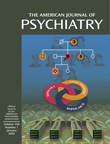To the Editor: We thank Drs. Meltzer and Shim for their thoughtful comments. Dr. Meltzer raises a valid issue that sertindole’s k
off is rather close to the range for typical antipsychotics, although the drug is an atypical antipsychotic. This is a valid concern; however, it is not just the k
off of the drug, but also its in vivo occupancy range, that is critical for atypicality. In that regard, sertindole at 8–24 mg/day occupies 61%–72% of D
2 receptors
(1,
2), which should give rise to response without extrapyramidal symptoms. Further, a patient taking sertindole, 20 mg/day, who had also received 100 mg of fluphenazine decanoate 52 days before brain imaging had 86% D
2 occupancy. This patient exhibited akathisia
(2), despite the fact that the patient would have had high 5-HT
2 occupancy.
We do not suggest that 5-HT
2 receptors make no contribution to the overall picture of atypicality. We propose that 5-HT
2 receptors are not necessary for atypicality, as shown by studies of amisulpride, remoxipride, and now aripiprazole, and that they are not sufficient for atypicality, as shown by studies of MDL-100907 and fananserin. Even in drugs with mixed 5-HT
2 and D
2 action, D
2 receptor affinity is the biggest factor for atypicality. In fact, Meltzer et al.
(3) stated, “The
low D2 affinity values of atypical drugs contribute more than their
high 5-HT2 affinity values” (emphasis added); 64% of the typical-atypical difference, as revealed by discriminate function analysis, was accounted for by low affinity at the D
2 receptor, and only 17% was accounted for by the addition of 5-HT
2 receptor affinity
(3).
Dr. Shim questions whether a slow k
on and low affinity could also give rise to atypicality. The affinity of a drug is the ratio k
off/k
on (not k
on/k
off, as Dr. Shim suggests)
(4). While current differences among atypical antipsychotics are driven mainly by k
off, it is possible in theory that if k
off were held constant, there could exist a low-affinity drug by virtue of a very slow k
on. However, it is important to understand that k
on and k
off are rate constants (not the rates of association and dissociation). The rate of association is a function of k
on multiplied by the concentration, whereas the rate of dissociation depends on k
off alone. Since low-affinity drugs are given at much higher doses than high-affinity drugs, even if the k
on (the association rate constant) were low, the rate of association would still be high because of the high concentration. This is why we think that low affinity and fast k
off, and not low affinity and slow k
on, is important to atypicality.
Thus, “atypicality” should be seen as a continuum rather than as a dichotomy. Antipsychotics become increasingly more atypical (i.e., have less chance of extrapyramidal symptoms) as their affinity at the D2 receptor decreases and their koff increases. We are not suggesting that antipsychotics with no D2 affinity are not possible, only that there are none at present.

